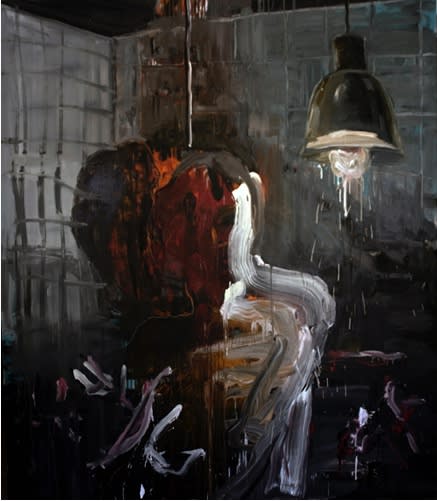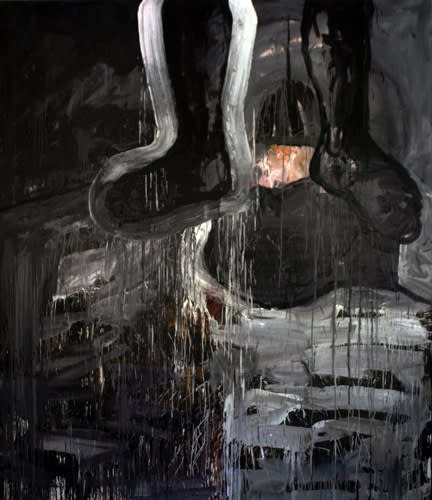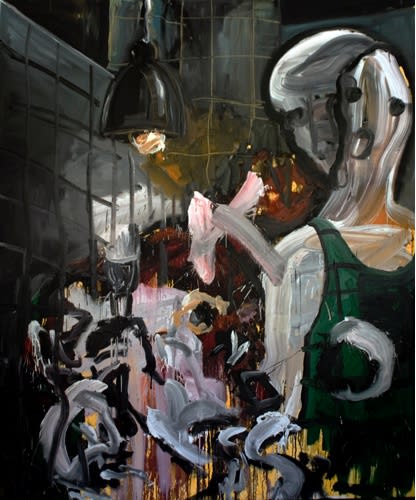Erdoğan Zümrütoğlu: Or I
“Painting Forces”: The “Or Else Paintings” by Erdoğan Zümrütoğlu
Dr. Özgür Uçkan
(Translated from Turkish by Deniz Şener)
“...it was new, and anything new is always tinted by the scourge of thunders and the pain of devastation”
Three forces readily become apparent in Zümrütoğlu's paintings: 1) Vertical action (fall/rise, spasm, contraction, tension, opening, hanging, rhythm, body line); 2) Violence (the violence of the paint, expression, sensation, the painting body); Dimension (space, area, amplification, void, a wide opening that engulfs the body)...
“Capturing” these forces Zümrütoğlu directly appeals to our nervous system. We immediately “apprehend” the forces with our senses, violently. Erdoğan Zümrütoğlu incorporates something new in Turkish art. He contemplates the dimensions, violence and the action of force. Whereas he contemplates via his painting, we comprehend a painting with our senses.
“As in art and music, it is not reproducing forms but rather capturing forces that matters in painting. (...) Klee's famous formula, ‘not render what is already visible, but rather to render visible’ is definitely tantamount to this. The task of painting is defined as the attempt to 'render visible' forces that are not themselves visible.”
“Or else” paintings harbor a multitude to watch at. These are paintings that are freed of the presumptuous rationality of the “is” verb and thus offer alternatives to both the gaze and senses, and consequently to the mind; and find their very expression in the plurality of possibilities of the “or else” connective.
The Danish linguist Louis Hjelmslev imagines language as a network of fluxes where it operates not through the "is" verb but instead with “and”, “or else” connectives, where the freedom of expression overrides the hegemony of the significant, or the coexistence of differences also annihilates the prevalence of the same. As a multiplicity of connotations, language exposes us to alternatives. Behind the object-language, “mythologies” function ... The very politics of language emerges here, but this is a structural politics, not a topical one.
Zümrütoğlu's paintings are not authoritative; rather they invite to investigate. They always accomodate an “or else” space, a breathing. Paintings speak for themselves. The narrated, the wrath of the paint, the dimensions of space that enhance perception, hung, burned, molten, the vertical rhythm of the “form-losing” body, the violence of the sensation...
Like a language about a language... A language which is the sum total of all possible stories.
Here we have the questions, events, liveliness, situations and attitudes that motivate these paintings. Real events that are experienced in places where the artist lives in and is necessarily bounded by; events with political consequences. Acid pools with bones popping out, little girls being shattered around into pieces, or children whose deaths are registered as “collateral damage”, “terrorists that are forced to commit suicide”, burning, melting, form-losing bodies, tortures, interrogations, one-person ghettos, co-conspiring mass inertia...
A deep and discharging wound which is permanently inconspicuous for a “society of spectacle” whose existence is appearance and whose truth is nothing but lies...
Notwithstanding, the paintings are not “about” these political events that ever take place. These paintings do not “tell” the story of these events.
Francis Bacon hails the distinction between a painting that “tells a story” and one which is “to be sensed”. Some paintings address the brain with a story to tell, but some only appeal to senses. “It is a very, very close and difficult thing to know why some paint comes across directly onto the nervous system and other paint tells you the story in a long diatribe through the brain.” Some paintings are “grabbed” in a snap. Such “grabbing” is enabled by concepts that are based on sensations and is momentous by nature. The grabbing strikes at the electro-chemical transmission speed of the neural system... You “sense” the painting...
“Or else” paintings counter the violence that accompanies the very formation of events with a violence that itself is internalized. By transferring the magnitude of the violence to the essence of perception, and reinventing bodies with an internal violence that deprives figures of their forms, it brings the event horizon closer to the borders of our field of sight. By opening up the “social wound”, it heals with “air and light”.... Like an anthroposophic shaman who, to heal by opening up the wounds of humanity, calls the lost unity of mankind with sensual concepts... “Taking deep therapeutical measures toward the social body”.
Zümrütoğlu appears to be a soul mate to the “painting euphoria” in the “slaughterhouse workshop” of Hermann Nitsch -with his “meat on the cross”- who happens to open an exhibition in Istanbul on the same day. Also to the holocaust landscapes of Anselm Kiefer where he depicts the tension between the burned-down, charcoaled earth and a distant dark sky that deems any escape impossible. But above all, to the triptychs of Francis Bacon... To Bacon, who by turning around faces and thus making heads stand out, offers the archaic power of form-losing bodies, or the violence that is spewed out of a shrieking mouth...
“This is because violence has two very different meanings: 'When talking about the violence of paint, it's nothing to do with the violence of war.' [Bacon] The violence of sensation is opposed to the violence of the represented (the sensational, the cliché). The former is inseparable from its direct action on the nervous system, the levels through which it passes, the domains it traverses: being itself a Figure, it must have nothing of the nature of a represented object. It is the same with Artaud: cruelty is not what one believes it to be, and depend less and less on what is represented.”
These paintings are political; not because their subjects are political but rather because their own social plasticity is their subject matter, that is, they are structurally political...
The “or else” paintings have huge dimensions. It incorporates such overwhelming dimensions because its plastic grammar that folds unto its own language stipulates it. These paintings are created by body dynamics where the whole body is utilized for this purpose. A “social plasticity” in action.
“Valéry says ‘the painter incorporates his body’. Indeed, we can never anticipate how a Mind would create a painting. The painter transforms the world into a painting, by offering his body to the world.”
The “or else” paintings establish a scenery that surrounds us, especially when in triptych format. Their huge dimensions appear even larger and try to depict that which is “left outside the painting”. The rhythm of the vertical action completes the mind. Zümrütoğlu's triptychs own themselves as much as it gets. “From Byzantian or Celtic sacrificial triptychs to Renaissance painters like Memling and Bosch, and to moderns like Beckmann or Bacon, the triptych format is preferred, due to the economy of expression it offers, by those who are in pursuit of the functional truth of art. The triptych accompanies you; it is a portable, mobile ‘stage’. It surrounds you. In its triply folded flow, it reinvigorates its narrative again and again. It ‘encompasses’ you. The triptych is the typical functional art. It does not need a wall, it stands on its own.”
Previously I had written the following. “Pursue the trace of process and time in Erdoğan Zümrütoğlu's minimal expressions, such that void flows into your spirit. This void is somewhat that of death. Life that rejects death is full of greed and violence but its hubris invites death. Remaining blind to others' death kills your spirit. You become incapacitated in grasping the relationship between the arena savagery fed by a hunger for spectacle and the ability to form a community. What makes you different than a killer when your spirit is dead?”
I still feel the same. But now I see that there is a living rhythm of flesh throbbing within this void... In these paintings the figure stands up as a whole body in one piece. A body which is in search for its spirit, and still hopeful for it.
“Body shall remain
devoid of spirit,
a spirit, that’s the sick”
NOTES
Gilles Deleuze, The Logic of Sensation, translated by Daniel W. Smith, Continuum, New York, 2003, p. 56
Author, academician, İstanbul Bilgi University Faculty of Communications, Department of Cultural Management
Jose Pablo Feinmann, La sombra de Heidegger / The shadow of Heidegger, translated by: A. Cengiz Büker, Doğan Kitap, 2009, p. 13
Gilles Deleuze, op. cit., p. 56
Louis Hjelmslev, Prolegomena to a Theory of Language. Baltimore: Indiana University Publications in Anthropology and Linguistics, 1953 [1943]
Roland Barthes, Mythologies, Seuil, 1970
Guy Debord, Gösteri Toplumu (Society of Spectacle), translated by: Ayşen Ekmekçi ve Okşan Taşkent, Ayrıntı, 2006
Francis Bacon, David Sylvester, The Brutality of Fact: Interviews with Francis Bacon, 1962, 1973, 3rd edition: Thames & Hudson, 1987, p. 18
Joseph Beuys, “Dernier espace avec introspecteur, interview de Gaya Goldymer at Mark Reihmann”, Par la présente, je n’appartient plus à l’art, L’arche, 1988, p. 105
Hermann Nitsch, Galeri Dirimart, 05.11.2009
Gilles Deleuze, op. cit. p. 39
Maurice Merleau-Ponty, Göz ve Tin (Eye and Mind), translated by: Ahmet Soysal, Metis, 1996, p. 32
Özgür Uçkan, “Şairi renklerle okumak” (Reading the poet with colors), Başka, n. 4, October 2008, p.74
Özgür Uçkan, “Bir Plastik sanatlar ekonomi-politiği: ‘Süs ve Suç, stil ve tasarım” (An Economy-politics of plastic arts: ‘Ornament and Crime’, style and design), rh+sanart, n. 5 July-August 2008, p. 41 (http://www.ozguruckan.com/?p=170)
Antonin Artaud, “La Conférence au Vieux-Colombier - Histoire Vécue d’Artaud-Momo”, Revue l’Infini, n. 34, Eté 1991, p. 22




